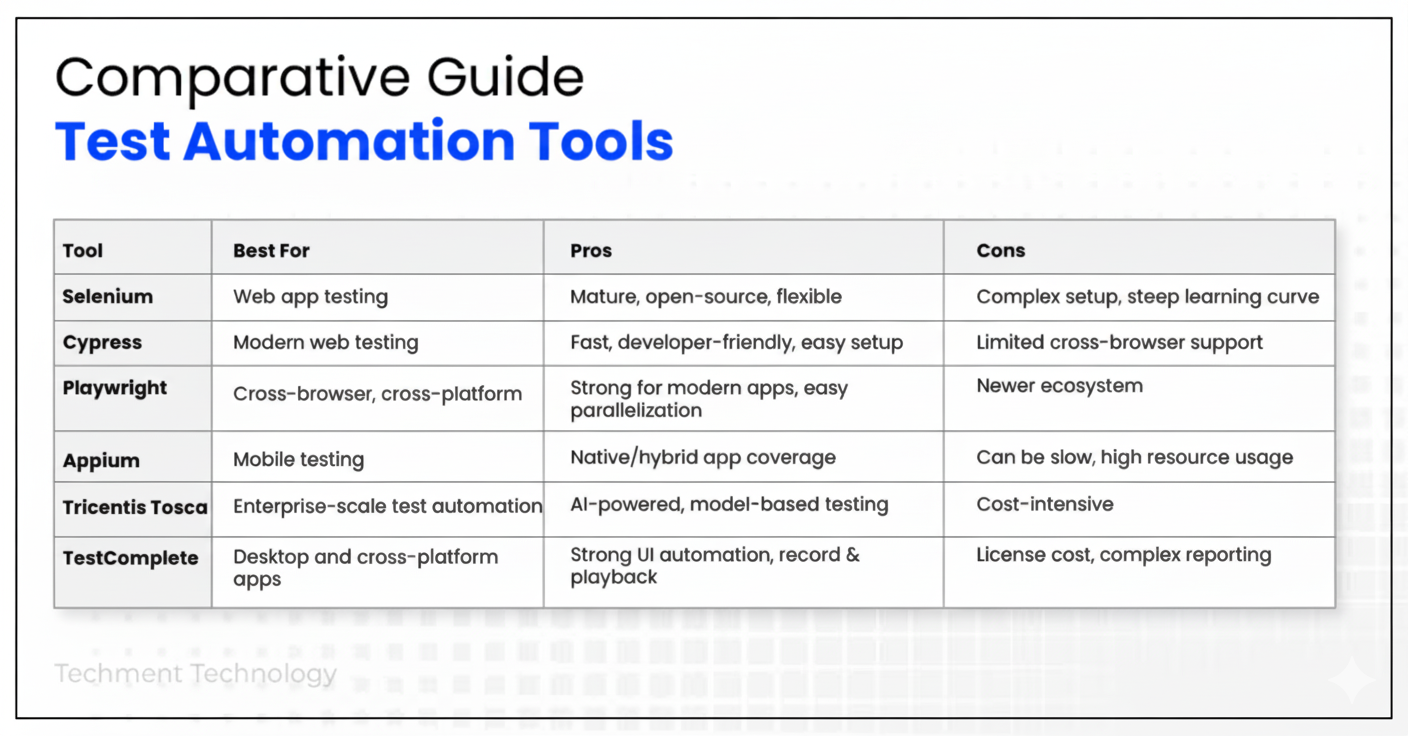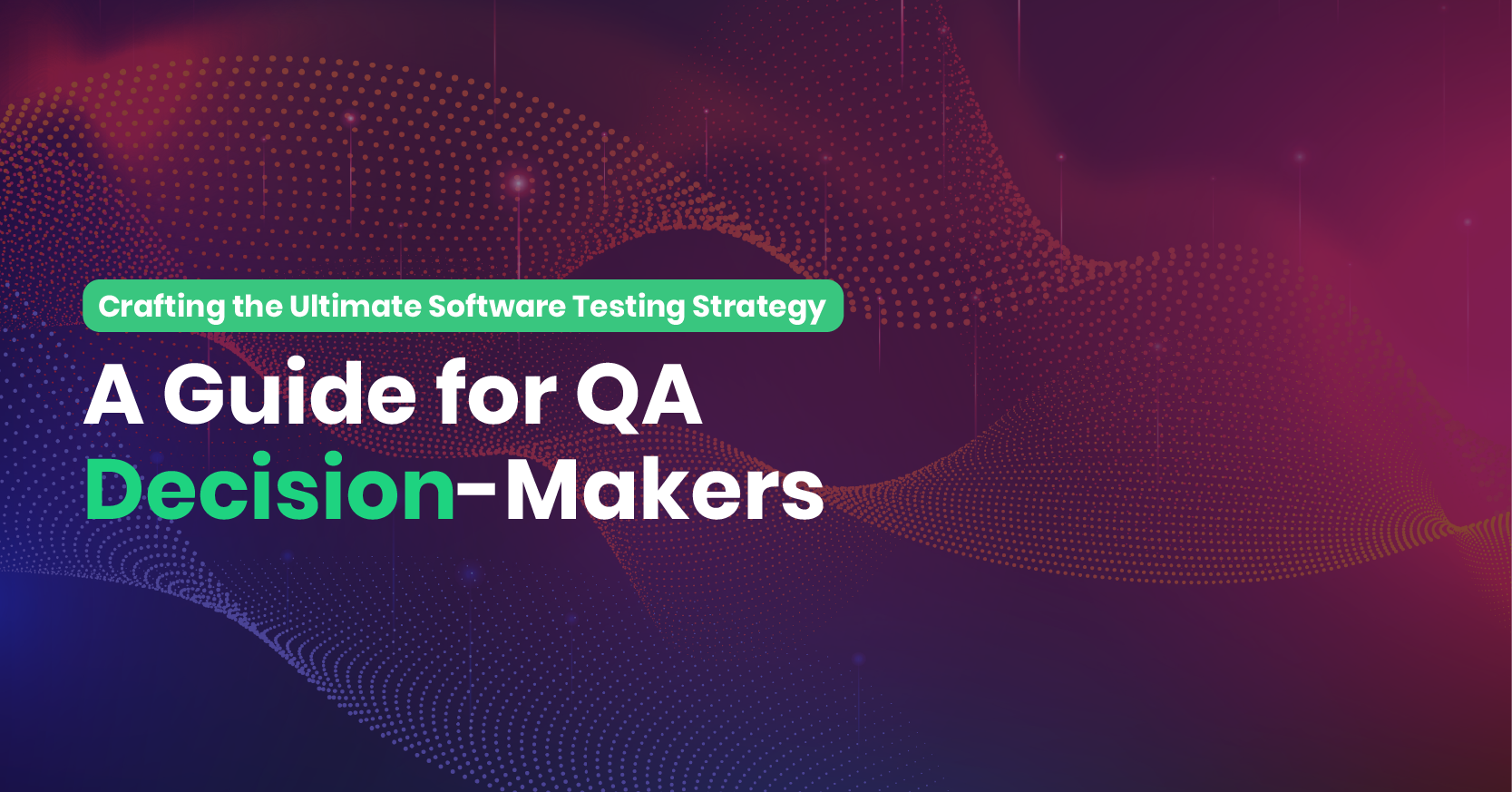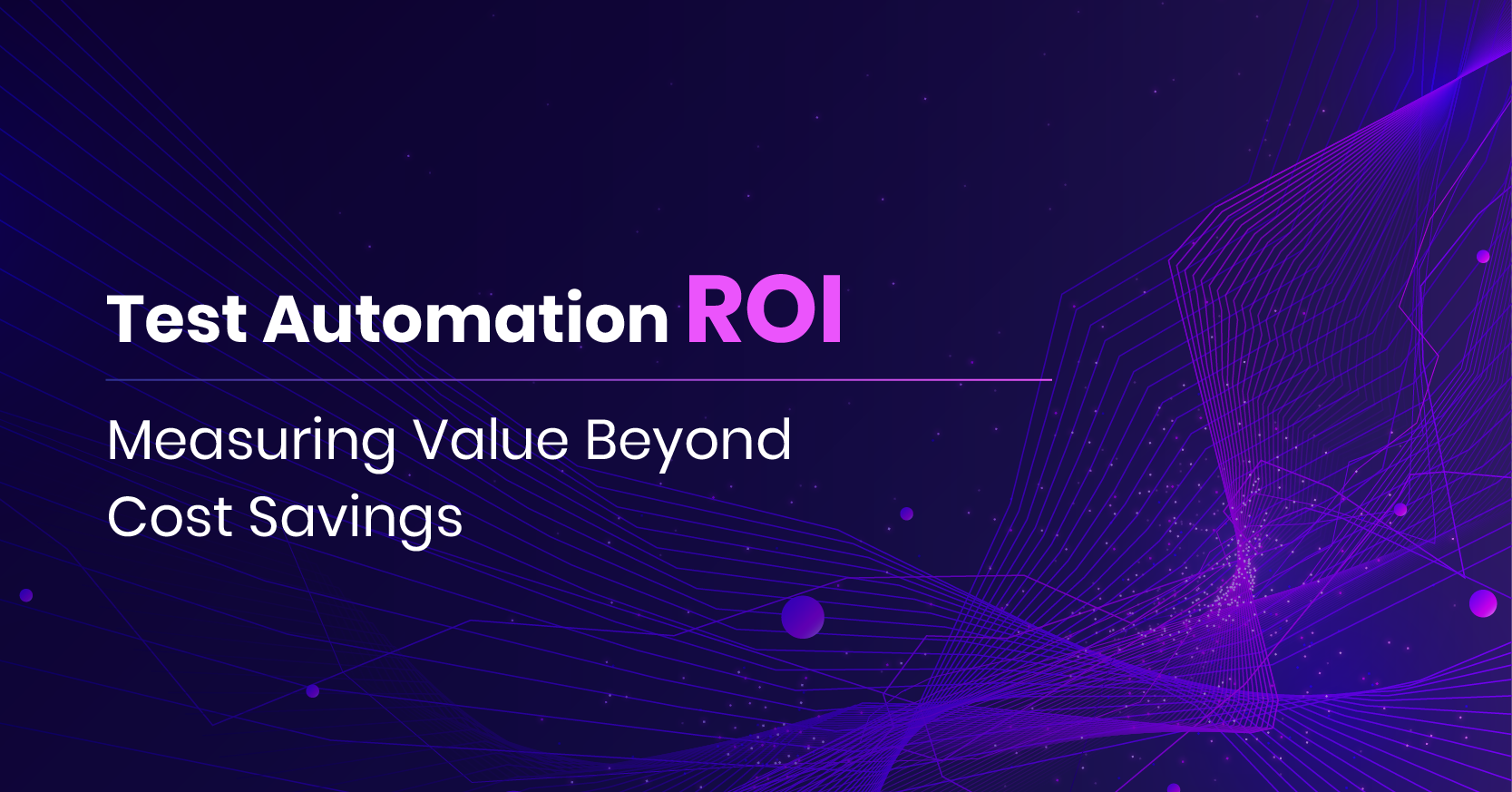The pressure on enterprises to deliver faster, more reliable, and high-quality software has never been higher. In this hyper-competitive digital economy, organizations cannot afford costly defects, sluggish release cycles, or scalability bottlenecks. Enter tools for test automation—the cornerstone of modern software quality assurance.
For CTOs, QA leaders, and product managers, the challenge isn’t whether to adopt automation—it’s how to choose the best test automation tools that align with their enterprise architecture, product roadmap, and digital transformation goals. With hundreds of automation tools and frameworks in the market, each claiming unique capabilities, leaders often face “paralysis by analysis.”
This blog serves as a comparative guide to test automation tools, breaking down top QA automation frameworks, highlighting key differences, and offering strategic recommendations for decision-makers. By the end, you’ll have clarity on how to evaluate, implement, and maximize the ROI of your automation investments.
For enterprises looking to assess automation maturity, explore our Test Automation Assessment Services.
TL;DR (Key Takeaways)
- Test automation tools accelerate delivery speed, improve test accuracy, and enable scalability in complex digital environments.
- Choosing the right tool requires evaluating framework compatibility, integration, scalability, and AI-powered capabilities.
- Leading tools like Selenium, Cypress, Playwright, Tricentis Tosca, TestComplete, and Appium cater to different testing needs.
- AI and ML are shaping the future of test automation by enabling self-healing tests, visual recognition, and predictive analytics.
- Enterprises should align tool adoption with long-term digital transformation strategies, not just immediate project needs.
Section 1: Why Tools for Test Automation Are Non-Negotiable
Software quality is no longer a back-office function—it’s a strategic business enabler. According to Gartner, organizations that adopt robust automation practices achieve 30–50% faster release cycles compared to manual-heavy testing environments.
Key reasons why automation tools are indispensable:
- Speed & Agility: Faster regression and functional testing cycles.
- Accuracy & Coverage: Reduced human error and expanded test coverage.
- Cost Efficiency: Fewer defects slipping into production.
- Scalability: Ability to handle cross-platform and multi-device environments.
- Future-readiness: AI-driven capabilities like self-healing scripts.
Learn more about our Quality Assurance Services.
Section 2: Categories of Test Automation Tools
Choosing the best test automation tools requires understanding their classification:
- Open-Source Tools
- Widely adopted (e.g., Selenium, Cypress, Playwright).
- Cost-effective but require skilled teams.
- Commercial Tools
- Enterprise-grade platforms (e.g., Tricentis Tosca, TestComplete).
- Offer support, integrations, and advanced features.
- AI-Driven Tools
- Tools like Testim and Tricentis Vision AI leverage machine learning for visual testing and predictive analytics.
- Niche/Domain-Specific Tools
- Example: Appium for mobile automation, Postman for API testing.
Read how AI is transforming automation in our blog: Vision AI in Test Automation.
Section 3: Comparative Guide to Test Automation Tools
Below is a comparative framework across popular tools:
Deep dive into resilience strategies: Boosting Test Automation with Testim & Tricentis.

Section 4: Test Automation Frameworks – The Backbone
A framework standardizes the way tests are written, maintained, and executed. Without it, organizations risk creating fragile, inconsistent test suites that quickly become a maintenance nightmare. According to the World Quality Report 2023–24, over 55% of enterprises cited framework design as a major factor in automation success.
Types of Test Automation Frameworks
Data-Driven Frameworks
- Store test data separately (e.g., in spreadsheets, XML, or databases).
- Allow teams to run the same test with multiple datasets.
- Ideal for regression testing where inputs and outputs vary.
Keyword-Driven Frameworks
- Use keywords to represent actions (e.g., “Login,” “ClickButton”).
- Lower the barrier for non-technical testers by enabling scriptless test creation.
- Works well in large teams with mixed skill levels.
Hybrid Frameworks
- Combine data-driven and keyword-driven principles.
- Provide flexibility while maintaining structure.
- Useful in large enterprise environments where diverse applications are tested.
Behavior-Driven Development (BDD) Frameworks
- Use natural language (e.g., Cucumber, SpecFlow).
- Enhance collaboration between developers, testers, and business stakeholders.
- Often adopted in agile and DevOps setups.
Model-Based Frameworks
- Create abstract models of application behavior.
- Reduce manual scripting through automation of test generation.
- Increasingly combined with AI and ML for predictive testing.
Key Considerations for Leaders
When selecting or building a framework, decision-makers should ask:
- Does it integrate with CI/CD pipelines?
- Can it support cross-platform testing (web, mobile, API, desktop)?
- How easy is it to maintain as the application evolves?
- Does it align with the skill sets of the QA team?
Explore how frameworks accelerate delivery: Test Automation Implementation Services.
Section 5: Data & Stats Snapshot
- 67% of QA teams report that test automation significantly reduces time-to-market (Capgemini World Quality Report 2023).
- 85% of enterprises believe AI-driven automation will be mainstream by 2026 (McKinsey).
- Companies using automation for >70% of testing achieve 5x fewer production defects (Accenture).
- Gartner predicts that by 2027, 75% of enterprises will standardize test automation as a business-wide capability.
Section 6: Top QA Automation Tools in 2025
- Selenium WebDriver
- Use Case: Web application testing.
- Why It Matters: Selenium remains the industry standard, with extensive community support. It supports multiple languages (Java, Python, C#) and integrates with almost every CI/CD tool.
- Limitations: High learning curve; complex test maintenance.
- Cypress
- Use Case: Modern web apps, especially front-end frameworks like React and Angular.
- Strengths: Fast execution, developer-friendly, built-in waiting, and real-time reloads.
- Limitations: Limited cross-browser coverage (mainly Chromium-based browsers).
- Playwright
- Use Case: Cross-browser, cross-platform testing.
- Strengths: Backed by Microsoft, it offers robust parallelization and supports Chrome, Firefox, Safari, and Edge.
- Trend: Quickly rising in popularity due to its developer-first design and CI/CD readiness.
- Appium
- Use Case: Mobile automation (native, hybrid, and mobile web apps).
- Strengths: Open-source, supports iOS and Android, reuses Selenium-based scripts.
- Challenges: Test execution can be slower; requires skilled setup.
- Tricentis Tosca
- Use Case: Enterprise-scale testing across applications (SAP, Salesforce, etc.).
- Strengths: AI-powered, scriptless, model-based automation with strong enterprise integrations.
- Limitations: Licensing cost can be high.
- TestComplete
- Use Case: Desktop, mobile, and web applications.
- Strengths: Offers record-and-playback alongside scripting in multiple languages. Great for organizations with mixed technical teams.
- Challenges: Licensing and infrastructure complexity.
- Testim.io
- Use Case: AI-powered automation for web and mobile.
- Strengths: Self-healing tests, visual test authoring, and predictive maintenance.
- Fit: Agile teams seeking faster creation and reduced flakiness
Discover the future: Top Software Testing Trends 2025.
Section 7: Strategic Recommendations
For CTOs and QA leaders, the right approach involves:
- Assess maturity: Use a structured assessment framework.
- Align with strategy: Choose tools that integrate with CI/CD and DevOps pipelines.
- Balance cost vs. scalability: Don’t just chase “top tools”—evaluate fit.
- Leverage AI: Future-proof with tools offering self-healing scripts.
- Upskill teams: Invest in continuous training for automation engineers.
Begin your journey with our Test Automation Assessment Services.
Section 8: Common Challenges & How to Overcome Them
Despite its promise, test automation is not a silver bullet. Many organizations struggle with adoption due to technical, cultural, and strategic barriers. Understanding these challenges—and proactively addressing them—separates successful QA leaders from laggards.
- High Initial Investment
- Problem: Automation requires upfront investments in tools, infrastructure, and skilled talent.
- Solution: Start small with pilot projects. Build ROI cases by targeting high-value regression suites before scaling enterprise-wide.
- Tool Overlap and Fragmentation
- Problem: Different teams often adopt their own tools, leading to redundancy and integration complexity.
- Solution: Establish a centralized QA CoE (Center of Excellence) to standardize toolsets and frameworks across the enterprise.
- Maintenance Overhead
- Problem: Tests break frequently as applications evolve, leading to high maintenance costs.
- Solution: Use AI-driven frameworks that support self-healing, dynamic locators, and modular script design to reduce fragility.
- Skill Gaps in QA Teams
- Problem: Many testers lack coding or automation expertise.
- Solution: Upskill teams through structured training, and leverage low-code/no-code automation platforms for non-technical contributors.
- Cultural Resistance
- Problem: Developers and testers often resist “shift-left” testing because it disrupts established workflows.
- Solution: Foster a DevTestOps culture, embedding testing early in the SDLC and incentivizing collaboration.
- Misaligned Expectations
- Problem: Leaders expect automation to deliver instant cost savings.
- Solution: Redefine success in terms of faster release cycles, higher coverage, and fewer production defects, not just cost reduction.
A McKinsey study shows that enterprises achieving >70% test automation coverage report 5x fewer production defects compared to those relying primarily on manual testing. However, success depends on addressing these strategic and cultural roadblocks.
See how AI simplifies complexity: Mobile Testing Without Limits.
Section 9: FAQ – Tools for Test Automation
Q1. What are the best test automation tools for enterprises?
Selenium, Tricentis Tosca, and TestComplete remain strong enterprise options, but choice depends on project needs.
Q2. How do I compare automation testing tools effectively?
Use criteria like cost, scalability, ecosystem support, integration with CI/CD, and AI features.
Q3. Are open-source tools reliable for enterprise use?
Yes, when supported by skilled teams and integrated frameworks. Many enterprises scale Selenium and Cypress successfully.
Q4. How do AI-powered tools change test automation?
AI enables self-healing, visual recognition, and predictive analytics, reducing script maintenance effort.
Q5. How do I know if my organization is ready for automation?
A readiness assessment evaluates maturity in process, people, and technology—start small, then scale.
Conclusion
The landscape of tools for test automation is rich, diverse, and evolving rapidly. For decision-makers, the challenge isn’t merely choosing a tool—it’s aligning automation strategy with business goals. With the rise of AI-driven frameworks and predictive analytics, automation is shifting from tactical execution to strategic enablement.
At Techment, we partner with enterprises to build resilient, future-ready QA practices that unlock agility, reduce risk, and accelerate digital innovation. Ready to transform your QA strategy? Explore our Test Automation Implementation Services today.
Related Reads
 All Posts
All Posts


